Art Fairs
Art Mumbai Opens With a Strong Debut Amid an India Art Market Resurgence
The city is seeing a period of sustained economic growth, and there are hopes this trend will extend to the art market.
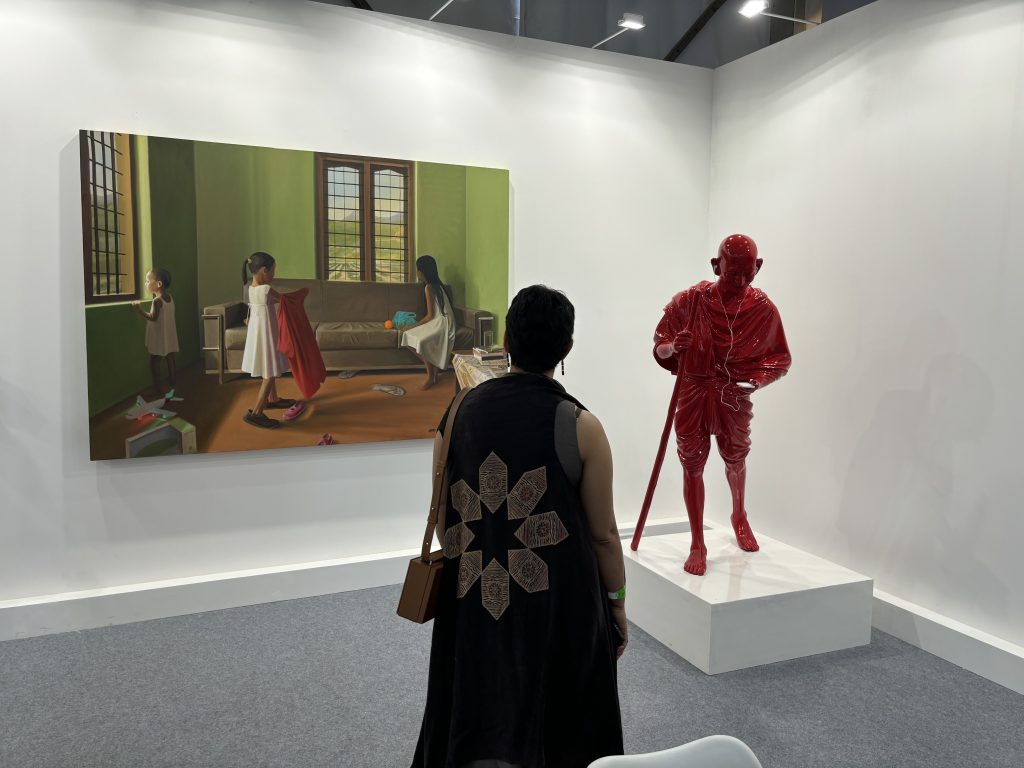
The city is seeing a period of sustained economic growth, and there are hopes this trend will extend to the art market.

Anindo Sen

Mumbai has had a lot to celebrate in recent days. The city had just woken up after a Diwali hangover triggered by an extended weekend of religious celebrations, mithai-fueled foodgasms, and lively parties, when the Indian national cricket team scored a pulsating win in the semifinals of the ICC World Cup on Wednesday. And just a few kilometers away, the inaugural edition of the contemporary art fair Art Mumbai hit a ball out of its own park with a successful opening day on Thursday, November 16 (the event runs through November 19).
The fair’s success is another sign of the recent resurgence in the Indian art market. So, what is behind this buoyancy? First off, India’s economy has scaled up significantly in recent decades, with more than six percent growth expected in the coming year, according to the Federation of Indian Chambers of Commerce and Industry. This is largely driven by private industry, particularly manufacturing, as global supply chains attempt to lessen their dependence on China.
The government also has ambitious plans to invest in digital infrastructure and support innovation and research in emergent technologies. Consequently, the International Monetary Fund (IMF)’s World Economic Outlook projects India to become the third largest economy in the world in less than five years, leapfrogging the U.K., Germany, and Japan to come just behind the U.S. and China.
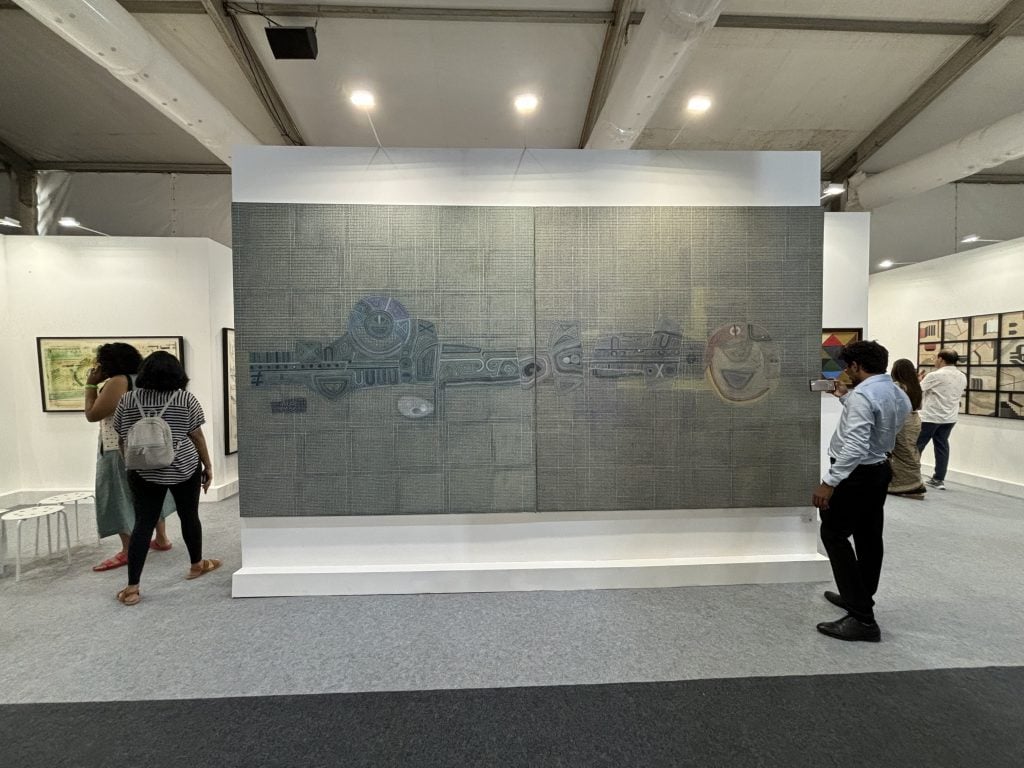
New Delhi and Kolkata gallery Akar Prakar’s stand at Art Mumbai. Photo: Anindo Sen.
Mumbai itself is the undisputed financial capital of India and is currently in hyper-wealth-creation mode. As the primary hub of private enterprise, the city has benefited from the growth in new business sectors and enterprises, which has spawned a whole new set of wealthy individuals. According to a Henley & Partners Report (2023), Mumbai already has more centi-millionaires (those with more than $100 million in investable assets) than Dubai, Sydney, Seoul or Miami. Outside the U.S. and China, only London and Singapore have more billionaires than Mumbai. The report also estimates that the number of centi-millionaires in Mumbai will grow by 80 percent over the next 10 years, a much faster rate than in other global cities.
The city has also been a beehive of gallery activity lately, further underscoring the need for a dedicated art fair. In addition to the opening of Akara Contemporary, an advisory-turned-gallery focusing on both Indian and international contemporary artists, TARQ moved into a larger space in Fort while Kolkata’s Experimenter gallery opened its first outpost in the city in Colaba. Chemould Gallery, which is currently celebrating its 60th anniversary, also opened Chemould CoLab nearby to support emerging artists last year. Building on the presence of legacy museums and heritage architecture, Fort, Colaba, and adjoining neighborhoods have morphed into a robust contemporary arts district in the city. And Mumbai Gallery Weekend, which was started by nine local galleries in 2012, saw 32 galleries participate in 2023.
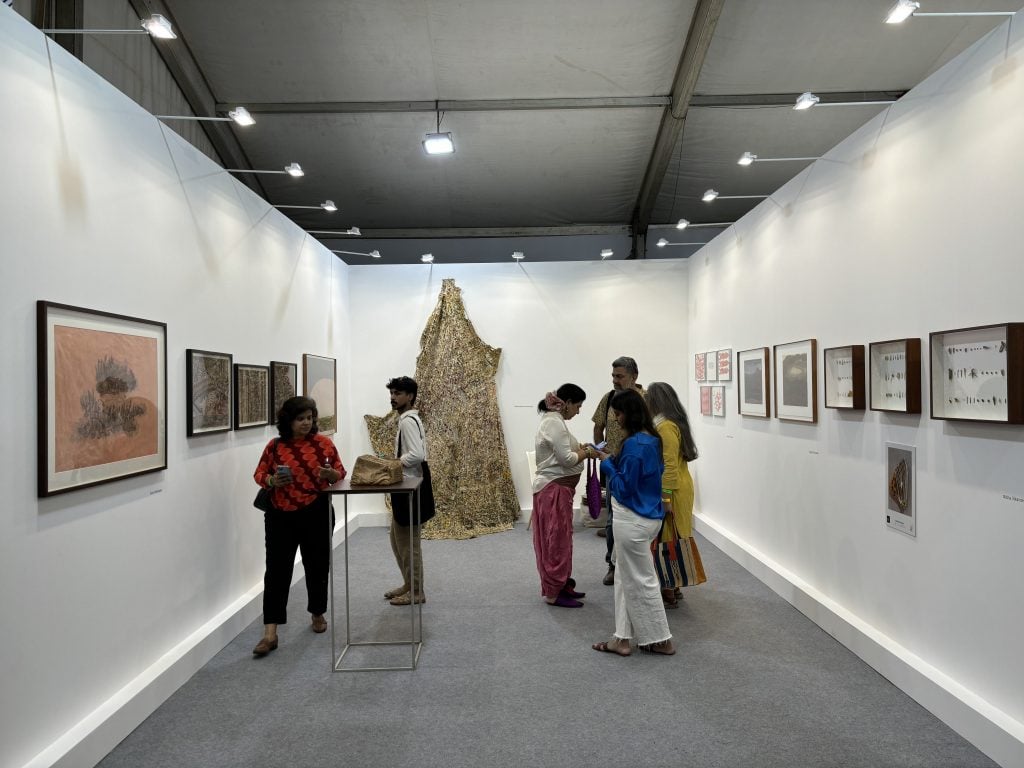
Mumbai gallery TARQ’s stand at Art Mumbai. Photo: Anindo Sen.
Now, Art Mumbai opened its first edition with 50 galleries—and interestingly, around half of them are from New Delhi, which already has its own India Art Fair, held in February. The international galleries taking part in the fair are either diaspora-owned or specialize in art from India. The programming additionally leans on Bollywood, fashion, and the performing arts, which are deeply embedded in the city’s cultural scene.
What makes the city especially attractive for the art industry is its existing cultural collector base and the greater appetite for contemporary art. “We have always sold more works to collectors based in Mumbai than Delhi due to the nature of the type of art we work with,” said dealer Peter Nagy of Gallery Nature Morte. “While there are exceptions, collectors in Mumbai normally are more open to experimental and progressive art forms, while collectors in Delhi tend to be more conservative in their tastes.”
Puneet Shah, the founder of Akara Contemporary in Mumbai, told me that in India, “younger buyers today are extremely well-travelled and their exposure and relationships are global.” He started Akara as an art advisory in 2009 and pivoted to a gallery model in 2015. This year, he opened Akara Contemporary to follow the evolution of his clients’ personal tastes. “They prefer a more eclectic collection.”
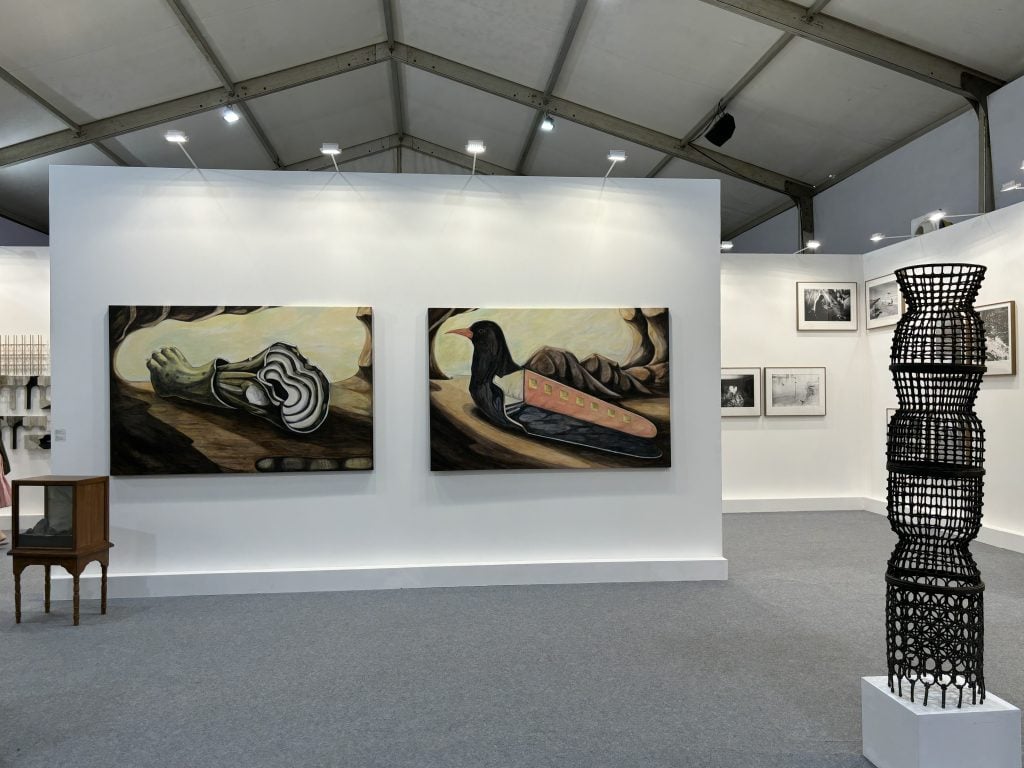
Kolkata and Mumbai gallery Experimenter’s stand at Art Mumbai. Photo: Anindo Sen.
Priyanka Raja, a co-founder of Experimenter Gallery, is encouraged by the number of clients in India who are invested in building a collection. What she finds remarkable is that a lot of the new interest is coming from smaller towns beyond the metros. “We are now selling works to clients in places like Jamshedpur, Surat, Raipur, Indore, Chandigarh and Pune. The base is now far more diverse and has expanded beyond the South Mumbai or South Delhi demographic,” she said, pointing to the rise in presenting art on digital platforms as a significant factor in this development. “Social media has broken the accessibility barrier further, both locally and globally.”
For Minal Vazirani, a co-founder of Saffronart and of Art Mumbai, the first year is about “building a platform which enables our galleries to showcase the best of South Asian art and artists to collectors, curators and institutions,” she said. In the long run, she hopes that they will be able to present Mumbai and its relationship with the arts to the wider world.
On the fair’s opening day, the ambience was almost festive. The event’s founders, Minal and Dinesh Vazirani, brought together key stakeholders, starting with their own existing auction house clients and local galleries, to leaders from private museums and biennales. The prevailing consensus seemed to be that collaboration is the way to take the Indian art market to the next level, and that everyone stands to benefit if the market expands in the right way. Many galleries also appeared to be making their presentations more accessible for first-time buyers, by including smaller or paper-based works in their booths.
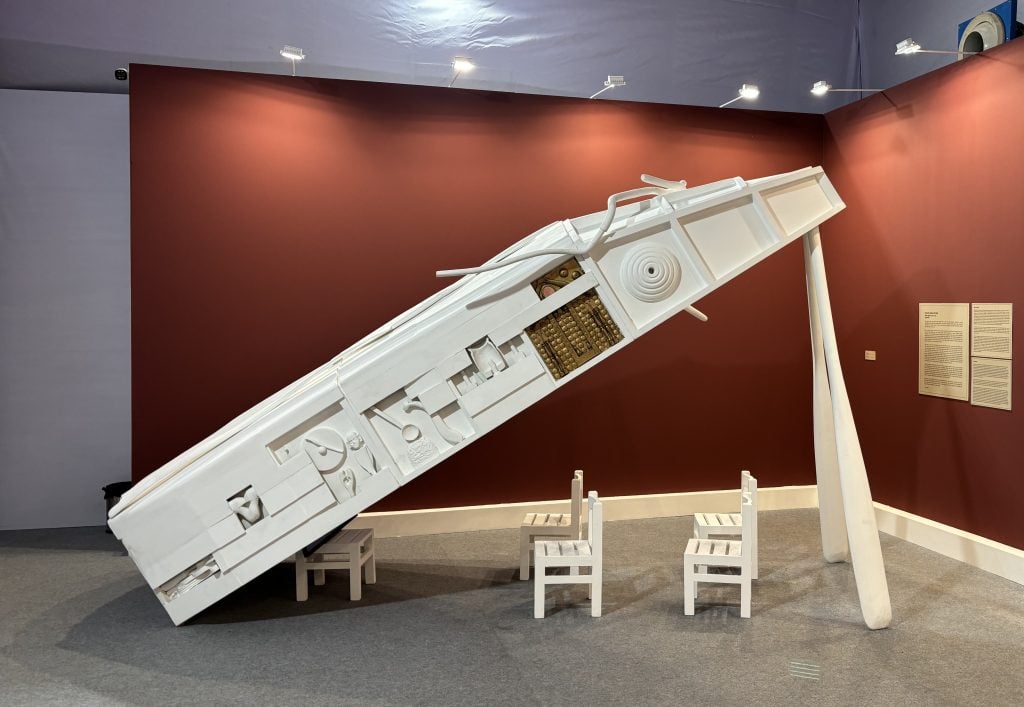
Kiran Nadar Museum of Art’s Tribute to artist Vivan Sundaram (1943-2023) at Art Mumbai. Photo: Anindo Sen.
New York-based AICON Contemporary, whose works ranged from $3,000 to $60,000, had sold 10 out of the 15 works on show in its stand by the fair’s first public day on Thursday. Buyers included both private collectors and institutions, including the private Kiran Nadar Museum of Art in New Delhi. Projjal Dutta, a partner at the gallery, was excited by the fact that his first two sales were to new buyers. “It is such a natural proposition that you must really ask—why wasn’t an art fair already happening in Mumbai?” he told me. “Commercial considerations apart, I also have long-standing relationships with collectors, friends and artists based here—and I grew up in India; it did not need any convincing for me to participate in this fair.”
Experimenter Gallery, with galleries in Kolkata and Mumbai, which also regularly participates in Frieze and Art Basel among other international art fairs, sold one or more works by each of the 17 artists they were showing on the opening day. The works on display ranged from $5,000 to $50,000. Raja, the gallery’s co-founder, said there was “tremendous energy” on the first day. “We are also very happy to note that we sold to new collectors whom we had not met before, which is unusual in a domestic fair for us,” she added.
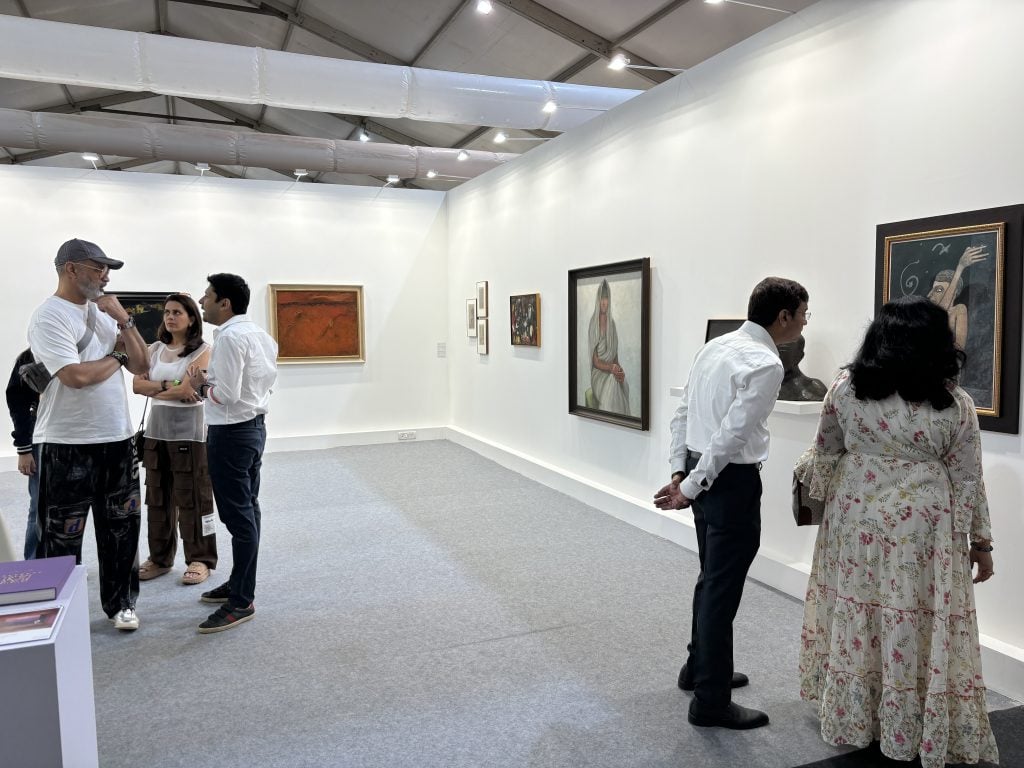
Mumbai advisory-turned gallery Akara Modern’s stand at Art Mumbai. Photo: Anindo Sen.
Sanya Malik of Black Cube, a young gallerist who was making her first appearance in an art fair, was charged up by the experience. “For a new alternate gallery model like ours without a physical space, art fairs are an imperative to connect directly with new clients,” she said. Black Cube was showcasing previously unseen works by Modern masters like Krishen Khanna, Thota Vaikuntam, and Jogen Chowdhury, alongside emerging contemporary artists, with prices ranging from $1,200 to $85,000. “Rest assured; we are already planning our return for the next edition.”
And the Delhi-born and New York-based artist Tara Sabharwal, whose works were on show at the Art Alive Gallery booth and who was visiting the city for the fair, ahead of a big solo exhibition in New Delhi next month, said: “What impressed me most was the exuberance, reflective of a sense of optimism against all odds. Optimism which is rooted in collectiveness.”
Art Mumbai is held at the Mahalaxmi Race Course, Member’s Enclosure in Mumbai, from November 16–19, 2023.
More Trending Stories:
Conservators Find a ‘Monstrous Figure’ Hidden in an 18th-Century Joshua Reynolds Painting
A First-Class Dinner Menu Salvaged From the Titanic Makes Waves at Auction
The Louvre Seeks Donations to Stop an American Museum From Acquiring a French Masterpiece
Meet the Woman Behind ‘Weird Medieval Guys,’ the Internet Hit Mining Odd Art From the Middle Ages
A Golden Rothko Shines at Christie’s as Passion for Abstract Expressionism Endures
Agnes Martin Is the Quiet Star of the New York Sales. Here’s Why $18.7 Million Is Still a Bargain
Mega Collector Joseph Lau Shoots Down Rumors That His Wife Lost Him Billions in Bad Investments